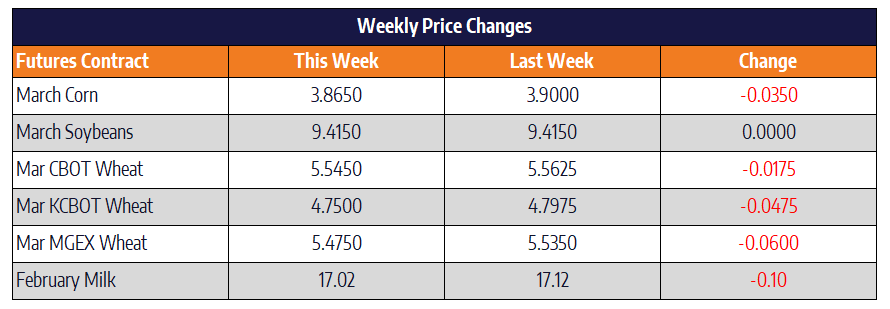Corn turns lower this week
March corn futures lost a nickel on Friday to close at 386-1/2, down 3-1/2 cents for the week. December futures were also lower closing at 400-3/4 down 2-3/4 cents this week. Ethanol margins were negative for a third week in a row on this week’s Ethanol Production Report. Margins had spent about two months at breakeven to positive territory dating back to late September. Spot ethanol margins are down 6.6% from last year’s levels. Corn used for ethanol needs to average 103.5 million bushels per week to meet this crop year’s USDA estimate of 5.375 billion bushels. Basis levels continue to remain firm across most of the country with corn deficit areas having the hottest basis bids.
Corn futures have struggled in recent years this time of the year to hang around the $4.00 mark. The market has traded mostly sideways for the last two weeks. The next big market mover will come on January 10 with the USDA’s WASDE report. Traders are calling for a cut to production, this would draw ending stocks below the two-billion-bushel mark. The USDA has made a slight cut to yield in January six of the last seven years. The average yield reduction dating back to 1993 is 1.4 bushels. The other side of the equation is the demand story. Demand has been stronger in the last few weeks but still lags well behind last year’s export pace and the five-year average.
Soybean market takes a beating Friday, closes lower on the week
Global markets were lower to start Friday after a US airstrike against Iranian leadership caused uncertainty and political tension. That uncertainty poured over into the day trading session Friday sending beans double-digits lower. March soybeans closed down 14-3/4 cents on Friday but were unchanged on the week finishing at 941-1/2. November beans held onto a 1-3/4 cent gain for the week to close at 971-1/2. Uncertainty as to the details of the Phase One deal with China remains at the helm for this bean market. Also, export sales came in Friday morning at a marketing-year low which was not a help to a market already headed lower.
Down in South America, soybeans are just starting to enter the blooming phase following the winter solstice back on December 21. Brazil’s third-largest growing region, Rio Grande Do Sul, received only 42% of their normal rainfall in the month of December. The far southern Brazilian state has also experienced temperatures 10 degrees warmer than normal in the last week. Crop stress has also been reported in Argentina, the world’s third-ranking soybean producer. Friday’s upcoming WASDE report ranks as the second most volatile report to the bean market. The USDA has cut bean yield in the last four years with the average January cut coming in 0.3 bushels lower.
Wheat starts the year lower
March Chicago wheat was down 1-3/4 cents on the week to close at 554-1/2. March KC wheat was down 4-3/4 cents to close at 475. March spring wheat was down 6 cents to finish the first days of 2020 at 547-1/2. Knee jerk reaction to the headlines Friday morning hammered the wheat market lower. Despite Friday’s action, the wheat market remains in an uptrend and now turns its focus to the WASDE report next Friday. US wheat stocks are expected to come in at near 5-year lows along with projected 2020 wheat acreage to come in at an all-time low. KC wheat made new 5-1/2-month highs this week while MPLS posted a new 2-1/2 month high. Today’s close is somewhat worrisome, after making new highs get current with sales if not already.
Dairy Spot Markets Turn Lower
Thursday’s dairy spot market trade showed a lack of willingness from buyers to move the markets higher. Both butter and whey had quiet sessions, holding neutral, while cheese and powder prices fell. The powder market fell a quarter-cent lower to $1.2275/lb while the block/barrel average fell 3.25c to $1.7725/lb. Another 3 loads of cheese traded hands during the session. Although the cheese market began the year lower, perhaps some sellers came in after the strong up days on Monday and Tuesday to sell some cheese at a premium.
The Class III market traded lower in the morning session and continued to the downside after the cheese trade. The market didn’t like to see both blocks and barrels fall, especially since recent trade has been shaky for each market. With the December contract settled and off the board, January is now front-month milk. January 2020 Class III fell 22c to $17.04 while January 2020 Class IV gained 13c to $16.92. From where it stands now, it appears as though January 2020 Class III milk will settle about $2 below where the December contract finished at.


